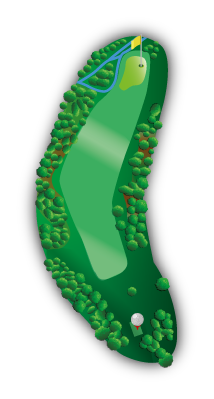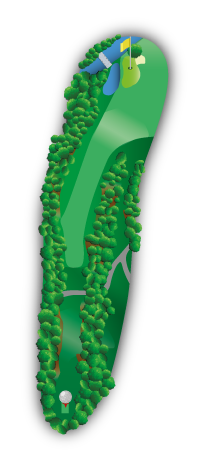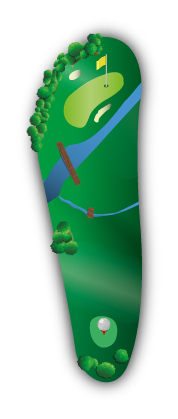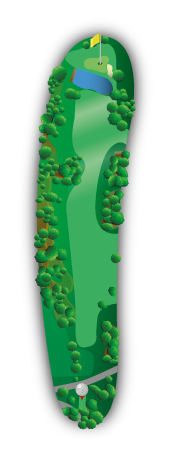Course History
Augusta is home to some of the most challenging holes in golf. The back nine holes separate champions from challengers and have been the scene of some iconic Masters moments. The 11th, 12th and 15th holes are particularly notorious, due to the myriad of challenges they pose to even the best golfers. Find out what makes these holes so tough, how past winners have overcome them and where others have failed.
- 11th Hole
- 12th Hole
- 15th Hole

11th: White Dogwood Par: 4 | 505 yards
This is widely considered the most difficult hole at Augusta. The great Ben Hogan once said of White Dogwood: "If you ever see me on the 11th green in two, you'll know I missed my second shot."
It has always been a demanding hole, but recent modifications have made it an even bigger source of fear among golfers (and of excitement among spectators).
It was the 2nd hole at the 1934 Masters and has been the 11th ever since. A long narrow beginning opens up to a green, with water on the front left and sand on the back right.
Rae’s Creek, which passes along the 11th, 12th and 13th holes at Augusta, was dammed in 1951 to form the pond that is still there today.
Although the green at White Dogwood was elevated by 2ft in 1965 the putting surface was washed away by a flood in 1990. However, thanks to cutting-edge laser technology based on a topographic map, it was restored to its previous contours before the 1991 Masters.
The tee has been moved back several times over the years because, in the words of architect Tom Fazio, "the hole was playing so short… we’ve made it a middle iron again."
In 2004, 36 pine trees were added to the right of the fairway. Several of these were removed before 2011, after Arnold Palmer complained they blocked the eyeline of spectators.
When White Dogwood was lengthened to 505 yards in 2011, it became the first par-4 at Augusta National to measure more than 500 yards.
Such is the difficulty level of this hole, only nine birdies were scored here in 2016, whilst there were 110 bogeys.

Famous for:
Larry Mize’s memorable 140-foot chip shot to win the Masters in 1987.
Mize was very much the underdog in a play-off with Greg Norman and Seve Ballesteros, but he played the chip shot perfectly and scored a birdie to become the first ever Masters champion from Augusta itself. Just look at those celebrations!

Bernard Gallacher Says:
"The 11th is a tough drive and long hole. The water to the left of the green means that the players can’t always attack the flag."
12th: Golden Bell Par: 3 | 155 yards
Golden Bell might be a considerably shorter hole than White Dogwood, but it’s every bit as difficult. After all, if Jack Nicklaus thinks it’s "the most dangerous par-3 in the game,'' you know it must be tough!
This hole is regarded as a rite of passage for elite golfers – the swirling winds are a big obstacle, and there’s the constant threat of a wayward shot ending up in the water. However, if the players can successfully negotiate all of this, they’ve got a strong chance of donning the green jacket.
Golden Bell started out as the 3rd hole at the Masters, before becoming the now notorious 12th hole. It has since undergone numerous changes, starting in 1939 when then-Chairman Clifford Roberts directed golf course architect Perry Maxwell to enlarge the green to the right of the hole.
Over the next 30 years, Rae’s Creek was dammed for flood control, an arch bridge was erected and named after Ben Hogan, and the putting surface was raised by 18 inches.
More recently, all greens were converted to bent grass in 1980, and coils were placed underneath the greens to circulate warm water around Augusta. In fact, Golden Bell was the first hole at Augusta to use undersoil heating on the green.
Golden Bell starts on the top of a hill and requires a tee shot over Rae’s Creek, which places strict emphasis on accuracy and control. This challenge can befall even the steeliest of golfers, as shown by recent events!

Famous for:
Jordan Spieth’s dramatic collapse in 2016.
Spieth led by five strokes heading into the back nine and was seemingly cruising to a second straight victory at Augusta, when he hit two balls into Rae’s Creek on the 12th and made a quadruple-bogey 7. Sheffield’s own Danny Willett capitalised on Spieth’s misfortune, going on to win the tournament by 3 strokes.

Bernard Gallacher Says:
"Although the 12th is a short hole, the green has no depth to it and the winds can be strong, so the players have got to be spot on with their clubbing. If they get it wrong, the consequences can be disastrous."
15th: Firethorn Par: 5 | 530 yards
Completing our triad of high-risk holes on Augusta’s back nine is Firethorn, a hole which allows no room for error.
Firethorn is undoubtedly ‘high risk, high reward’ – it has the highest average score at Augusta at 4.78 – and if the players can bypass the pond guarding the front of the green, they’ll give themselves every chance of success. However, those who lay up face a hard wedge shot from a tight downhill lie.
In the words of Canadian golfer Adam Hadwin: "A little short you’re in the water. A little long you’ve got a difficult up-and-down. So, for me it all depends on the drive."
Originally the 6th hole, Firethorn became the 15th hole after the 1934 Masters and was the scene of Gene Sarazen’s historic double eagle that helped him win the 1935 Masters. Sarazen famously remarked that his shot could be heard "round the world".
The first major change to this historic hole was made in 1949, when the surrounding creek was dammed and piped underground. This backed the water up into a hollow, creating the pond in front of the green that you see today.
1955 was another significant year in the history of this hole, in which a formal dam was established to the left of the pond and the Gene Sarazen Bridge was built in honour of the great man’s historic victory.
By 1970, the pond had been widened, the tee had been moved back 40 yards, and a series of high mounds had been installed on the right side of the fairway.
Between 1970 and 2000, Firethorn’s official yardage was reduced by 500 yards, mounds in the rough were removed and clusters of pines were planted next to this hole.
As of 2005, a new tee has been built which sits 30 yards behind and 20 yards to the left of the old one.

Famous for:
Sergio Garcia’s epic eagle at the 2017 Masters.
Sergio Garcia faced falling behind Justin Rose on the second nine in 2017 and needed to conjure up a moment of magic from somewhere. This moment of magic came on the 15th, when he made an epic eagle which prompted rapturous roars from the Augusta crowd. Feast your eyes on this...


